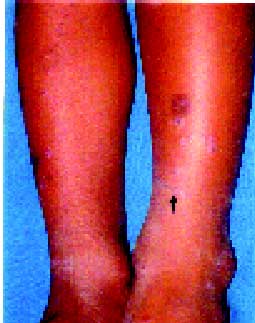An eight-year-old boy presented with moderately itchy, violaceous
papules on both legs and forearms of 2 months duration. There was no
mucosal, nail or hair involvement. Koebner’s phenomenon, defined as
appearance of new lesions along the line of trauma or scratch was
positive (Fig. 1). Lesional biopsy revealed hyperkeratosis, focal
hypergranulosis, irregular acanthosis and diffuse basal cell
degeneration with dense upper dermal lymphocytic infiltrate,
characteristic of Lichen planus. Topical application of a potent topical
steroid, clobetasol proprionate (0.05%) twice daily with systemic
antihistamine led to marked decrease in itching and subsequent
resolution of lesion with residual hyperpigmentation in 6 weeks period.
 |
|
Fig. 1. Violaceous papules both legs with
positive Koebner’s phenomenon (arrow). |
Lichen planus (LP) is a pruritic dermatosis of
unknown etiology that affects skin, oral and genital mucous membranes,
nails and hair. The classic form presents with symmetrically
distributed, violaceous, papules commonly involving the flexor aspects
of wrists, legs and lower back. LP is mostly self limiting and resolves
after a variable period ranging from few months to years, leaving behind
hyperpigmentation and/or scarring. Differential diagnoses in children
include lichenoid drug eruption, psoriasis, plane warts and pityriasis
rosea. LP is uncommon in children accounting for less than 2-3% of all
adults cases.
Archana Singal,
Deepika Pandhi,
Department of Dermatology and STD,
University College of Medical Sciences & GTB Hospital,
Delhi - 110095, India.
E-mail:
[email protected]
